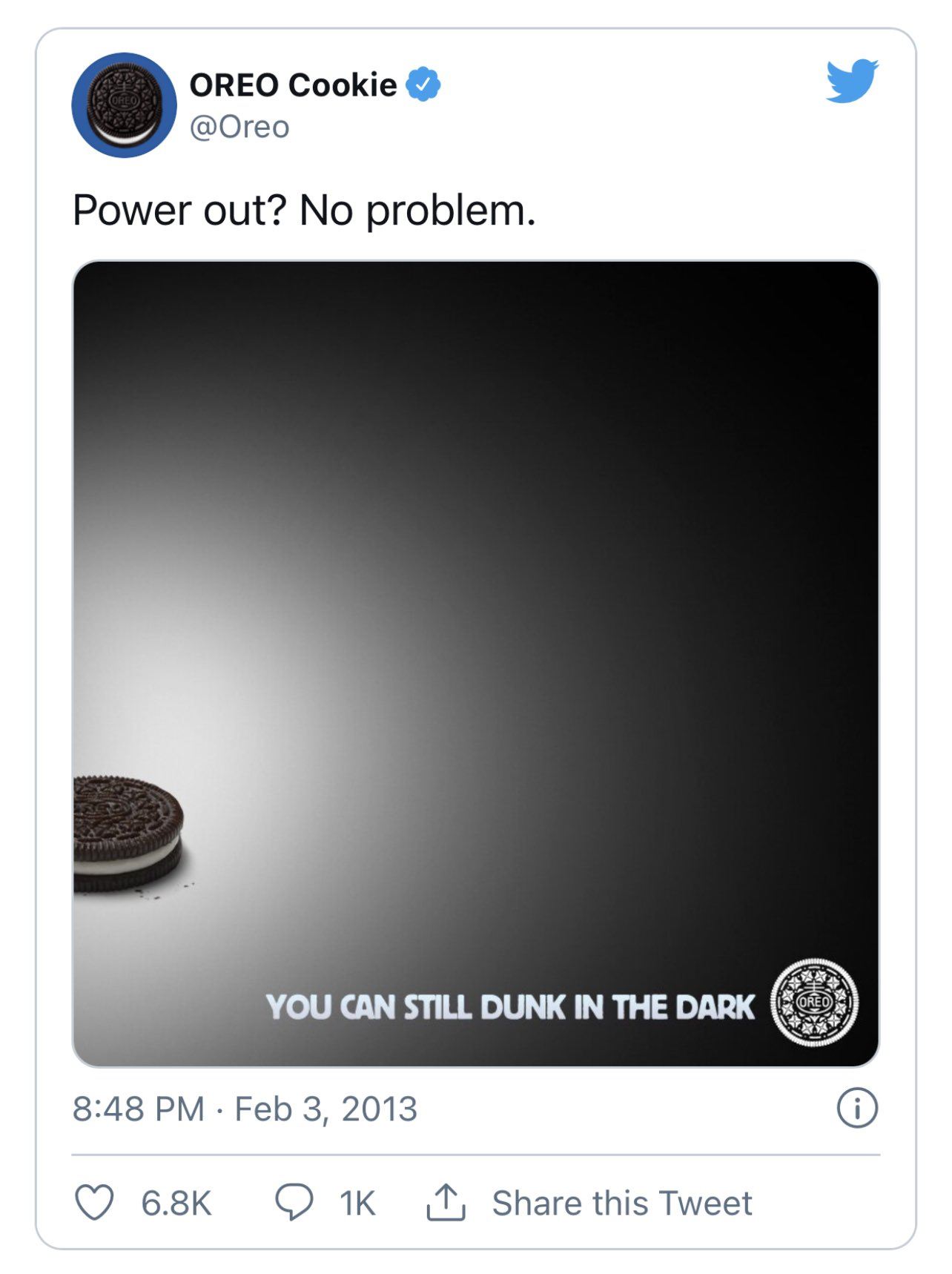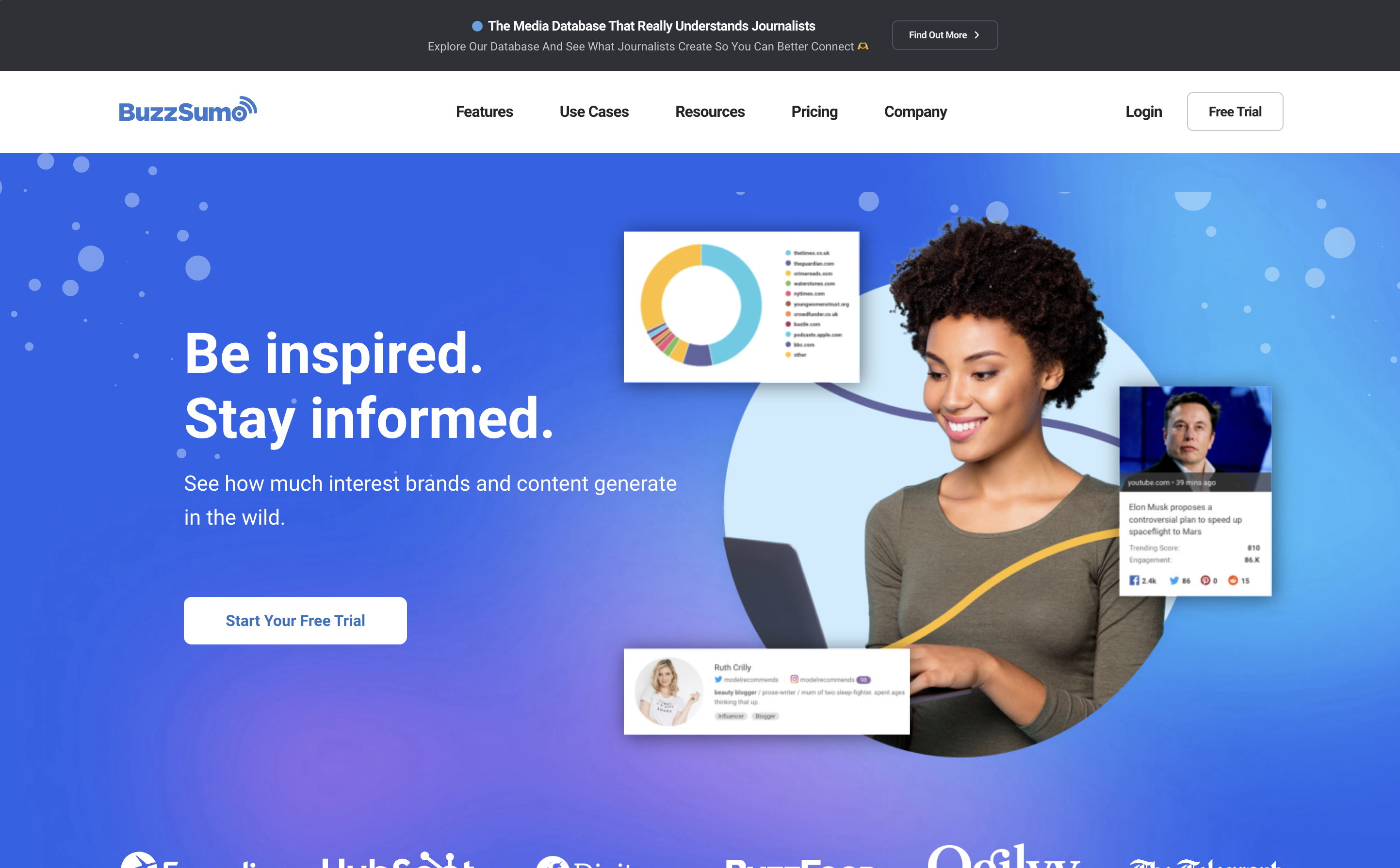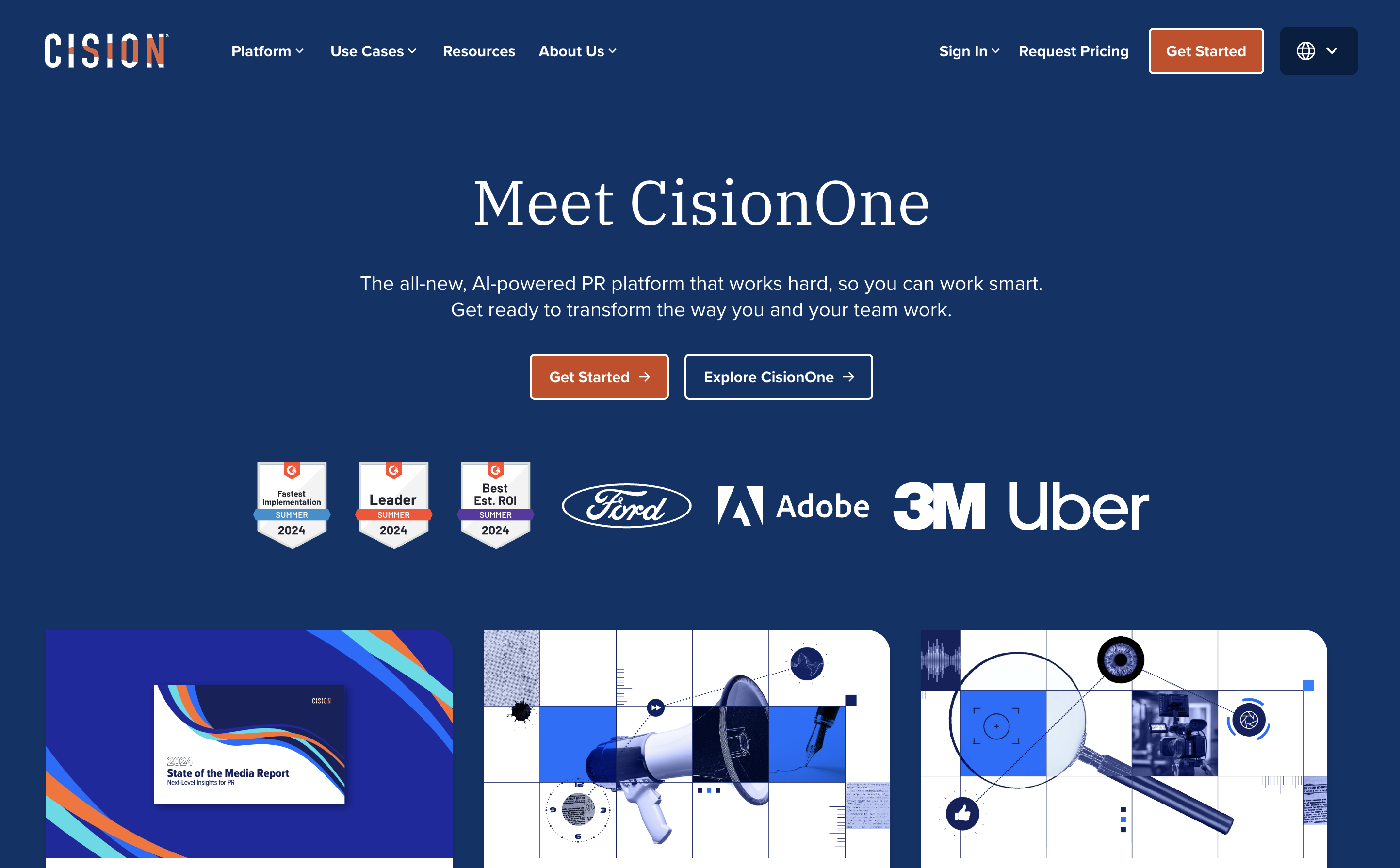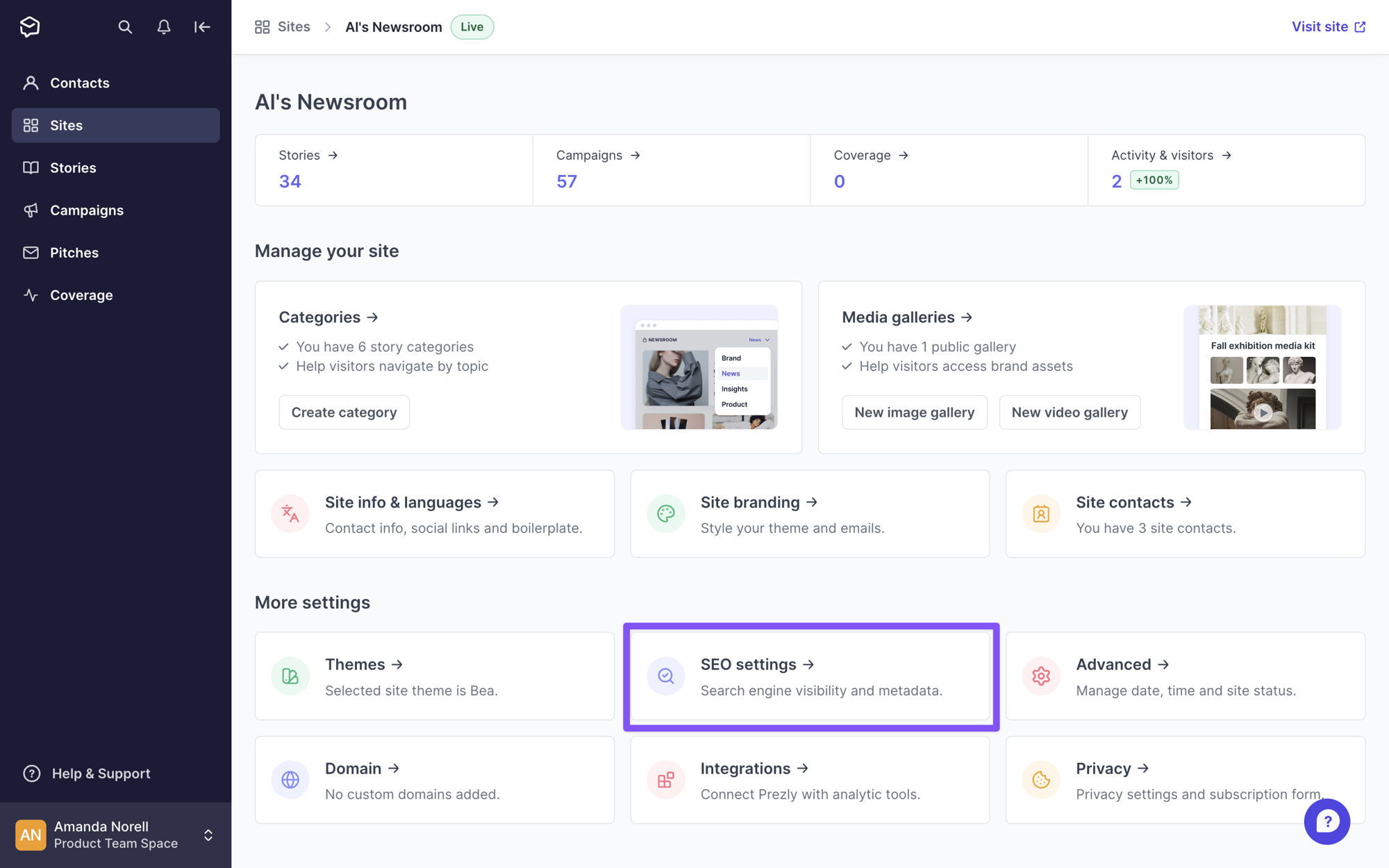Earned media strategy: How to, tactics, tips & more
How to get high-quality earned media coverage opportunities for your brand
Getting featured in the news isn't really as hard as it sounds. Below we explain what earned media is, how it differs from other types of media, and (most importantly) how to get it.
Prezly – software for modern PR teams
Write & publish brand stories in an online newsroom
Send email campaigns, pitches & newsletters
Manage all your contacts in a single CRM, with easy import & export
Measure performance with analytics & built-in media monitoring

Earned media is all the free exposure your brand gets that you didn’t pay for or create yourself. Think of it as publicity you earn, not buy.
It’s the hardest to get but super powerful for building credibility. Unlike paid ads or content you create (like your social posts or blog), earned media comes from real people spreading the word.
This includes:
- Articles and news mentions
- Customer reviews and testimonials
- Social media shoutouts and reposts (aka social media PR)
- People sharing your product publicly
- Positive word-of-mouth
In short, earned media is the kind of buzz that shows people genuinely like what you do, which makes it way more impactful.
When we talk about media strategy within the communications industry, we tend to think about three types of media: paid, owned, and earned.
Paid media is any exposure you pay for.
This includes things like ads on Google or Facebook, influencer marketing, or sponsored posts in magazines.
Paid media is great for quick reach. You control when, where, and how your message appears. But it’s obviously temporary: once you stop paying, the exposure stops.
Owned media is all the content you create and control directly.
This covers things like your website, PR blog posts, social media profiles, PR newsletters, and PR podcasts (or PR roundtables, if you're so inclined).
Owned media lets you shape your brand’s message however you want, and it’s long-term. You decide what to say, when to post, and how often, which makes it a reliable, consistent way to connect with your audience.
However, to distribute your owned media, you'll likely need to follow a hybrid approach, sharing it on your non-owned social channels (Facebook, Twitter/X, Youtube, etc,).
Rand Fishkin explains how this works:
Earned media is the “free” stuff you don’t pay for or control, when others mention or promote your brand because they genuinely want to.
This includes customer reviews, social media mentions, press coverage, and shoutouts from happy customers.
Earned media is harder to get, but it’s incredibly valuable because it comes from real people who aren’t on your payroll.
This type of media builds trust and credibility since people tend to trust recommendations from others over ads or branded content.
Summing it up: paid media is all about reach, owned media is your space to share, and earned media is the trust-building gold you can’t buy directly. The right mix of all three helps boost visibility, trust, and long-term growth.
Earned media might seem too good to be true.
Why would anyone promote your brand for free when companies spend billions on paid exposure each year? Yet, earned media is exactly that: authentic, unpaid attention that builds trust and credibility.
This is why PRs and marketers work so hard to earn it. People share and talk about brands that offer something worth spreading, whether it’s an amazing product, standout service, or relatable message.
In the next section, we’ll cover the top four reasons why people give brands earned media.
Thought leadership is about being an industry expert who shares valuable insights.
While controversial, Elon Musk is a famous example of a PR thoughtleader. His views dominate headlines, making him a walking billboard for brands like SpaceX and Starlink.
But you don’t have to be Musk to be a thought leader. Experts like Brian Dean from Backlink boost their brands and provide credibility to journalists through sharing their own expertise.
Thought leaders attract attention and build trust simply by sharing what they know.
The internet’s demand for content is endless, with people constantly scrolling.
Media outlets need fresh material to keep audiences engaged, so if you can provide valuable, compelling content, you’re likely to earn media coverage.
Content can be much more than announcements, too. It might be an interesting event, a human-interest story, new research, or a trendy product an influencer loves.
Providing content that resonates with audiences increases your chances of getting noticed by the media.
People naturally prefer to work with those they know, like, and trust. This is especially true in media, where a journalist’s reputation is always on the line.
Many journalists have been burned by unreliable sources, so they value relationships with brands that consistently provide value.
Building trust puts you at the forefront when journalists decide which sources to use, which stories to cover, and which brands to highlight.
Companies often earn media simply by excelling at what they do.
When a brand is popular, well-liked, and provides quality service, customers naturally spread the word through X mentions, reviews, Reddit PR threads, referrals, and more.
Earned media isn’t just press coverage, it’s any authentic buzz that gets your name out there. Social proof from real customers is powerful and drives credibility in a way paid ads can’t.
Prezly – software for modern PR teams
Write & publish brand stories in an online newsroom
Send email campaigns, pitches & newsletters
Manage all your contacts in a single CRM, with easy import & export
Measure performance with analytics & built-in media monitoring

Earned media doesn’t just happen, it takes planning.
Building a strategy that gets people talking about your brand authentically can create a steady stream of buzz and credibility.
Here are ten tips to help you develop an earned media approach that’s genuine, strategic, and gets results.
Understand who your audience is and what they care about.
An earned media strategy is most effective when it’s built around real audience engagement.
The more you know about their preferences, pain points, and interests, the easier it will be to create content and experiences they’ll want to share.
Content that’s valuable, informative, or entertaining will always get more attention.
High-quality content naturally encourages shares, mentions, and media coverage, giving your brand more organic visibility.
Create content that people can’t help but talk about. Think original research, insightful blog posts, or entertaining videos.
Respond to comments, join relevant conversations, and show up where your audience hangs out online.
Engaged brands are more likely to earn mentions and recommendations.
Building relationships within your community (and with some of the best PR communities) creates trust and increases the likelihood that they’ll share your brand with others.
Encourage happy customers to leave reviews and testimonials.
When people see others endorsing your brand, it creates a ripple effect, leading others to trust you.
Social proof is a powerful way to earn credibility without paying for it, making it a key element of any earned media strategy.
Journalists are always looking for sources and stories.
Reach out, introduce yourself, and share your expertise. Don’t pitch nonstop. Instead, focus on building a relationship with a journalist over time.
When you’re known and trusted, journalists are more likely to cover your brand when the right story comes along.
If those journalists are saved in your Prezly account, too, you can also keep close track of every interaction you've had with them from our PR CRM (and add your own notes along the way).

Whether it’s a unique product feature, an interesting company story, or a bold perspective, give people something to talk about.
Offering a fresh angle or something different makes your brand more memorable and appealing, increasing the chance of earned media mentions from audiences and press alike.
Highlight your customers and their success stories to show how your brand makes an impact.
Real customer stories resonate with people and can lead to organic word-of-mouth.
When potential customers see relatable success, it makes them more likely to trust your brand and share it.
Consistency builds familiarity, which can lead to trust and loyalty.
Keep your messaging, tone, and brand values steady across all platforms.
The more people see your brand showing up consistently, the more likely they are to remember you, mention you, and recommend you.
Keep track of what people are saying about your brand, then adapt your strategy based on that feedback.
Staying responsive to trends and audience sentiment will help you stay relevant and increase your chances of positive mentions.
Use a PR analytics tool like Prezly to monitor mentions, comments, and reviews regularly.

When your brand is mentioned, share it!
Retweet, repost, and thank the person or publication. Acknowledging mentions shows appreciation and encourages more people to engage with your brand.
Sharing earned media reinforces credibility and helps build stronger connections with your audience.
Executing an earned media strategy takes a mix of planning, engagement, and tracking.
Start by setting clear goals. Know what you want to achieve, whether it’s more reviews, social mentions, or press coverage.
Then, create high-quality, shareable content and learn how to get influencers to share your product. Make it easy for others to share by providing assets or ideas. Keep track of mentions, analyze what’s working, and adjust as needed.
Remember, it’s all about genuine connections. Earned media thrives on authenticity, so stay consistent and value every piece of feedback you receive.
A great example of an earned media strategy could be to focus on reactive PR through social media.
Take Oreo’s “You Can Still Dunk in the Dark” tweet during the 2013 Super Bowl.
When a power outage paused the game, Oreo’s team quickly tweeted a clever image captioned, “You can still dunk in the dark.” The tweet went viral, racking up millions of retweets, likes, and tons of media coverage. All without a dollar spent on ads.

Budget-friendly PR tactics like this show how a brand can leverage quick thinking and humor to spark genuine buzz and earn media attention.
How did they do it? They had focused on establishing a social media PR strategy that allowed them to:
- Monitor current events relevant to their audience and brand tone
- Have people who could react to the event as it unfolded
- Establish processes that allowed those people to react fast, without having to wait days for their tweet to get sign-off in-house
In reality, the Oreo team didn't set out to react to the Superbowl outage – but because of processes established through their social media strategy, they were able to act fast when the opportunity presented itself.
Prezly – software for modern PR teams
Write & publish brand stories in an online newsroom
Send email campaigns, pitches & newsletters
Manage all your contacts in a single CRM, with easy import & export
Measure performance with analytics & built-in media monitoring

An earned media strategy takes more than luck, it’s about using the right tactics to encourage others to talk about your brand.
Here are five proven tactics to help you earn media naturally and in a way that’s authentic, valuable, and memorable.
Make content people want to share (blog posts, videos, infographics, or research with a unique angle). That goes for your online newsroom too.
Shareable content amplifies your reach and increases your chances of being mentioned across different platforms.
When your content is helpful, interesting, or visually engaging, people are more likely to share it.
With Prezly, we've worked hard to make sharing your content as easy as possible. You can even directly embed and share your stories right from our PR email outreach tool.

Identify influencers in your industry and start building connections.
Engage with their posts, share their content, and provide value.
When influencers trust you, they’re more likely to mention your brand authentically, introducing you to a broader audience in a credible, organic way that builds trust.
You'll also get more opportunities to run successful influencer marketing campaigns, which can be super impactful when executed well.
If those influencers are saved in your Prezly account, too, you can also keep close track of every interaction you've had with them from our PR CRM (and add your own notes along the way).
Ask happy customers to leave reviews on platforms like Google, Yelp, or industry-specific sites.
Reviews build social proof and are powerful for earned media. After all, any potential customers will trust real feedback from other users.
Positive reviews can also attract media attention, helping your brand gain further reach and credibility.
Get involved in relevant online discussions, whether on social media, forums, or blogs.
Share your expertise, offer insights, and contribute meaningfully.
When people see your brand as an expert or valuable resource, they’re more likely to mention it in future discussions, boosting your earned media presence.
Hosting an event or webinar gives people a reason to engage with your brand and talk about it afterward.
Whether virtual or in-person, events provide a platform for interaction and networking, which can lead to social media mentions, reviews, and even press coverage.
All valuable forms of earned media.
Tracking earned media means keeping tabs on brand mentions, shares, reviews, and coverage across channels.
With Prezly's media monitoring tool, you can simplify this by monitoring all mentions in one place, linking coverage to specific journalists, and auto-updating contact records.
This means you can track exactly what’s working, build stronger relationships, and fine-tune your PR strategy.

Managing earned media doesn’t have to be overwhelming if you have the right tools.
Whether it’s tracking mentions, connecting with journalists, or seeing what’s trending, these tools can help keep things running smoothly.
Here are five tools to help you build and measure your earned media efforts.
With Prezly, we've built an all-in-one PR toolkit.
It lets you keep tabs on your mentions, link coverage to specific journalists, and easily manage your media contacts.
If you’re tired of juggling different platforms, Prezly’s dashboard simplifies everything, making it easier to stay organized and keep your earned media on track.
Prezly – software for modern PR teams
Write & publish brand stories in an online newsroom
Send email campaigns, pitches & newsletters
Manage all your contacts in a single CRM, with easy import & export
Measure performance with analytics & built-in media monitoring

Google Alerts is a classic, free tool that emails you whenever your brand or keywords pop up online.
It’s basic but gets the job done if you just want to stay in the loop without a big investment. Set up alerts for your brand or industry, and you’ll get notified as soon as something’s mentioned.
Mention is like Google Alerts but on steroids, covering social media, blogs, forums, and news sites in real time.
It’s awesome for tracking brand sentiment and spotting trending topics. Plus, you can use it to keep an eye on competitors, so you know how your brand compares.
BuzzSumo helps you find what’s popular in your industry by showing you which content is getting shared and who’s sharing it.
It’s perfect for content-driven strategies, especially if you’re trying to figure out what’s grabbing people’s attention on social media.
Cision has a bit of everything.
Media monitoring, a journalist database, and solid reporting features. It’s especially useful for managing outreach and seeing the impact of your earned media efforts over time.
It’s a decent choice if you’re looking to build relationships with journalists and track your progress (but beware, Cision's pricing is high!).
Looking to score some quality earned media?
At Prezly, we see all kinds of successful strategies. So, we've tapped into our clients’ insights to bring you real examples of earned media opportunities and how brands make them happen.
CSR in PR is about giving back, whether by donating to charity or supporting meaningful causes.
It’s not only a great thing to do but also a powerful media opportunity.
People love brands that give back. 70% of consumers want the companies they support to care about social or environmental causes.
👉 Read more about how to promote CSR (without sounding like you're bragging)
A strong SEO game puts your brand in front of reporters looking for expert sources.
And, if your content is an authority in a specific niche, others will reference it too.
Quality SEO means you’re the go-to for journalists and a tasty backlink source for other brands.
To make this easier for you, we've added Press Release SEO settings directly into Prezly. That way, your stories are always ready to appear on Google.
Try Prezly for free
Reviews are everything: 91% of people read them before buying, and 84% trust them as much as personal recommendations.
Positive reviews are earned media gold, showcasing real customer satisfaction to attract new buyers and help build a loyal following.
Good relationships with journalists means better coverage, not just now but also down the line.
When reporters trust you as a reliable source, they’re more likely to come back for future stories. Strong media relations create a lasting earned media stream.
If you'd like to learn more about how to build a good relationship with the media, here are some more resources:
- How to build a better PR media list (+ the best tools & template)
- PR Roundtable: How writers want to be pitched
- How to get press coverage for your business or brand (without being annoying)
A strong approach to PR & media pitching is key to getting noticed.
Whether it’s a unique perspective or a fresh angle, quality content that adds value to journalists’ work helps you stand out and gain organic coverage.
With our PR outreach tool, you can send personalized pitches to 100s of contacts at once (without hitting spam). Giving your stories an even better chance of being covered by multiple journalists.

Press releases are still a PR classic.
A well-placed release that’s relevant to a publication’s audience can drive impactful earned media.
They may be old-school, but press releases still get results when done right.
That's why at Prezly, our press release tool comes with everything you need to create engaging press releases without any headaches.

Ready to create your own press release?
- Publish and share professional, multimedia press releases
- Translate to 30+ languages in seconds with AI
- Free for your whole team for 14 days, no payment info required

We can talk about earned media strategies and the benefits of earned media all day, but what about the challenges? Why doesn't everyone just pursue earned media and ignore the others?
Pitching stories, building relationships with the media, and researching journalists and publications takes time. Time that could be better spent going viral on TikTok? Maybe. Maybe not. Either way, it will be an investment.
Paid media is faster. Owned media is faster. Both are easier. Can't really argue with that.
You can pitch all day, every day, and you may never get coverage.
That is one distinct benefit both owned and paid media have over earned: there's a sense of control over the coverage you get. With owned, you can make more content. With paid, you can buy more exposure.
With earned, you're pretty much fully at the whim of the media, your customers, influencers, and anyone else who has something to say.
Unfortunately, when it comes to content that you do not have control over, you don't necessarily get to decide if it's positive or negative.
Sometimes you may get a bad media mention or product review, or an unfavorable opinion. You could go viral for the wrong reasons.
There's not much you can really do about it beyond reacting with tact and striving to do better if the criticism is valid.
What are your thoughts on earned media? Give us a shout on Twitter/X. Or see how Prezly can support your mission to get that sweet, sweet earned media coverage with a neat 14-day free trial.
Securing earned media takes time.
It could be weeks or even months, depending on your strategy. Building relationships with journalists, growing your online presence, or gaining customer reviews doesn’t happen overnight.
Consistency, quality content, and authentic engagement will help you earn media organically, but patience is key.
Earned Media Value (EMV) estimates the monetary worth of your organic mentions, shares, and coverage.
It’s like measuring how much you’d spend to get similar exposure through ads.
Just like other formulas for calculating PR, EMV helps you see the value of earned media as part of your overall strategy, showing ROI on organic efforts.
Each type has its place.
Paid media, or pay-to-play media, is great for quick visibility, owned media lets you control your message, and earned media builds trust.
The best strategy usually combines all three: paid media for reach, owned media for consistency, and earned media for credibility and authenticity.
Prezly – software for modern PR teams
Write & publish brand stories in an online newsroom
Send email campaigns, pitches & newsletters
Manage all your contacts in a single CRM, with easy import & export
Measure performance with analytics & built-in media monitoring

Ready to start growing your media reach?
With Prezly you can publish press releases online, and share them directly with journalists. 14-day free trial, no credit card required.






